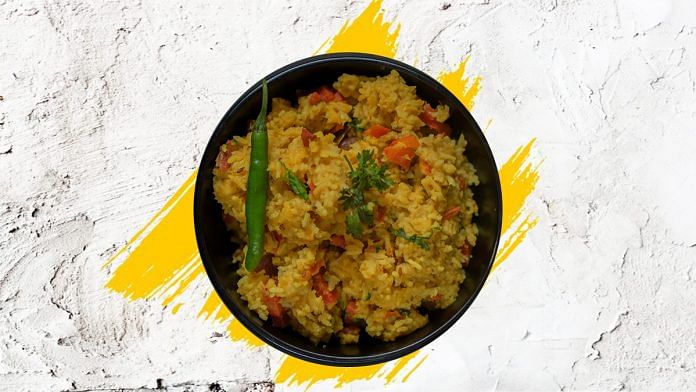The humble khichdi is the safest option for India’s ruling party.
The Bharatiya Janata Party (BJP) has decided that the way to the heart of the electoral beast is through food. And unlike its previous attempts at subtracting from the menu (read the beef ban), the BJP now wants to ‘woo’ Dalits with a giant 3,000-kg vat of khichdi.
The ‘Samrasta (or harmony) khichdi’, as the party is calling it, will be cooked Sunday at Delhi’s Ramleela Maidan. About three lakh Dalit households will provide the rice and the pulses needed to cook the khichdi. And if Dalit appeasement was not enough, the khichdi will also try to win an entry into the Guinness Book of World Records. BJP president Amit Shah is slated to attend this event.
For the BJP and Dalits, the khichdi seems to have become the lowest common denominator.
A party whose members have prioritised vegetarian food over and over again (to the extent that even Quora now has the question, “Will India become a vegetarian nation under BJP rule?”), khichdi is a humble and safe option, acceptable and known to most citizens and homes in India.
Maharashtrian chef Vishnu Manohar and his team are going to attempt to cook the khichdi. Manohar is the author of books like Let’s Tofu and B-Baby-Corny, and his website calls him the “most admired chef in central India”.
Curiously, while the raw grain and pulses will come from Dalit homes, the cooking itself will be led by a non-Dalit.
Also read: How the humble khichdi conquered the world
Why khichdi
Khichdi is everywhere. It is a simple, easy-to-cook one-pot meal.
I have previously attempted to trace the history of this rice and pulse dish. Originating in India, khichdi travelled far and wide, becoming a staple wherever it went.
In England, the kedgeree — thought to be introduced by British or Scottish officers — lacks the pulses synonymous with khichdi and is usually made with rice, fish and boiled eggs, and eaten as a breakfast dish. The kedgeree was an instant hit because it suited their bland palate.
In Egypt, it became the kushari — a spicy rice, lentil, tomato and macaroni mix. Some even call it the ‘national dish’ of Egypt.
In India itself khichdi has a lot of variants, its ingredients varying from region to region. The Bengali khichuri, the Kannadiga bisi bele bhaat, the Tamil pongal, the Haryanvi khichri made with bajra, and the Odiya adahengu khechidi are just some of them.
Even Moroccan scholar Ibn-Battuta, who visited India in the 14th century, mentions ‘moong khichdi’ in his travel accounts.
The Mughals, of course, upped their game. Their recipe combined equal parts of pulses, rice and ghee to make the dish — it was garnished with culinary jewels like nuts, rose petals, kaftan and fruits. Jahangir, the recovering alcoholic son of emperor Akbar, preferred to eat the Gujarati khichdi, which he called Lazizan, on the days he abstained from meat. “It is not devoid of flavour, and it suited me well,” Jahangir had written in his memoir.
Khichra—the name given to the meat variant of the dish—is available in Hyderabad, Bengal and even Pakistan. It is certainly not this variant of khichdi that will bubble in the BJP’s melting pot Sunday.
Also read: Dalits lash out at BJP leaders’ visits to their homes, call them ‘pointless’ and a ‘farce’
Dal to Dalits
‘Dalit’ and ‘Dal’ find their etymologies in Sanskrit. Dal signifies ‘split’ or ‘divided’ (like the pulses) and the term Dalit supposedly comes from the same source to describe those who have been oppressed and broken. It is likely that social reformer and Dalit icon Jyotirao Phule had first used the term to convey the same sentiment.
Most political parties today choose to ignore Dalit foods altogether, instead using their homes and plates for photo-op moments. BJP leaders Adityanath, Amit Shah, Ravi Shankar Prasad, Suresh Rana and Yeddyurappa claimed to have #LunchWithDalits — as if it was a necessary tick box in their respective poll campaigns.
However, look closely and you’ll find dal mein kuch kaala hain. Indeed, something is amiss.
These visits were mostly just optics or reek of hypocrisy. Ravi Shankar Prasad had his #LunchWithDalits at a 5-star hotel, while Suresh Rana’s meal was brought from outside, not cooked at a Dalit home. And while BJP president Shah stuck to vegetables and rice, Adityanath—the UP CM—made sure Dalits got soap and shampoo to ‘purify’ themselves before he reached their village.
Surely, the top leadership of India’s political parties may not even have heard of any Dalit dishes and their variants across regions, let alone have them. Because of continued Dalit oppression, these dishes developed pan-India out of basic and minimal ingredients—low on spices (expensive ingredients) and chicken, fish and eggs (expensive proteins).
Rakti, a delicacy, is made of coagulated blood and, if available, onions. Wajadi is made from cleaned animal intestines, and salt and chilli powder.
Also read: ‘Eating with Dalits’ is only a photo-op and election strategy for the BJP
But as a storm brews over eating meat in India, even the most basic ingredients in Dalit foods have been sprinkled with terror and fear. “Delight, shame, secrecy, reclamation, and protest are recurring themes in Dalit literature and conversation about food,” writes Sharanya Deepak in her thought-provoking article There is No Dalit Cuisine.
Be sure, no such food will make it to Ramleela Maidan Sunday. Neither will it be mentioned. After all, so many Indians have been killed because of suspicions over the food they eat. But khichdi is safe and it’s pan-Bharat.
And khichdi will be fed through spoonfuls of appeasement — after all, it is what all of us can and do eat.




Many years ago, a Dalit friend took me home in Poona for an impromptu lunch. Wife served us delicious mutton.